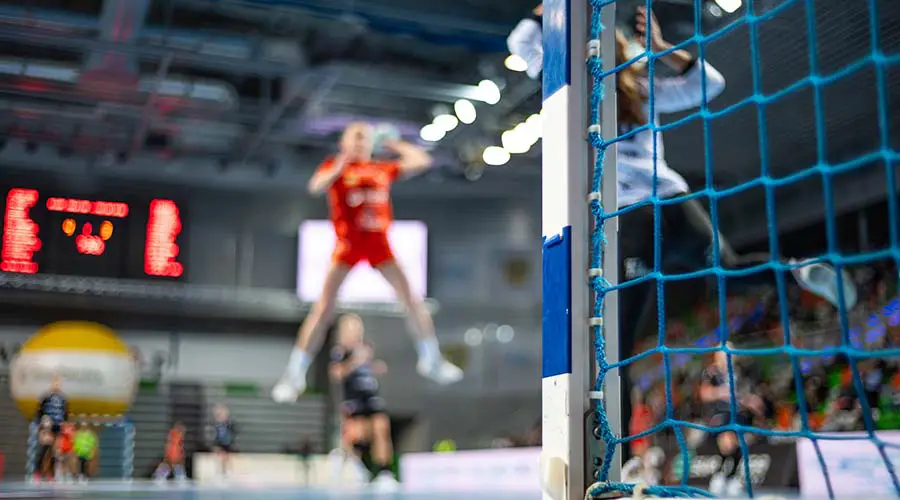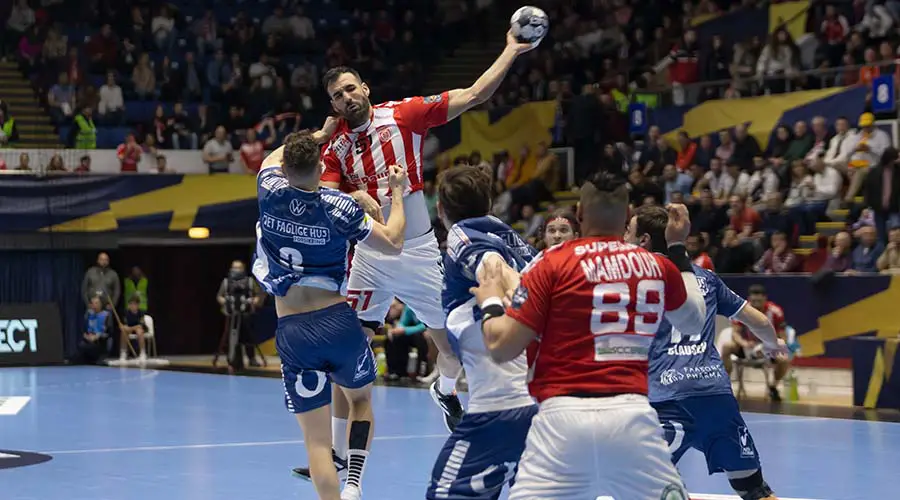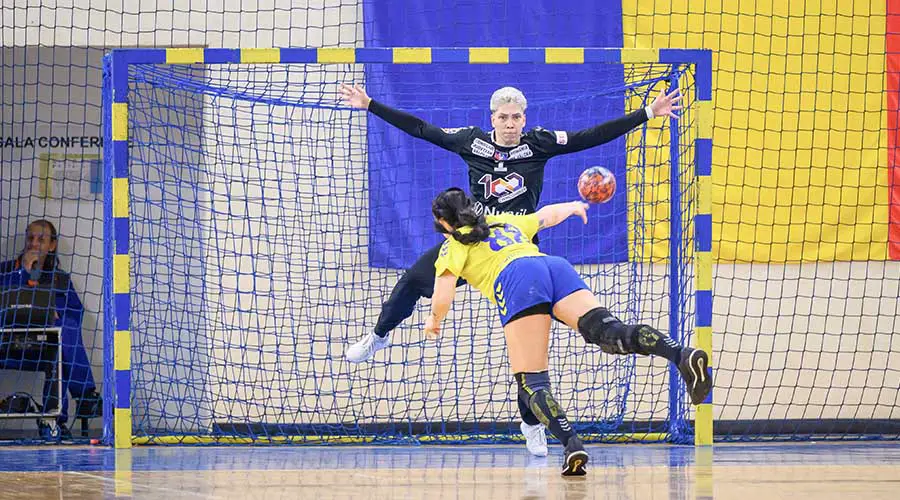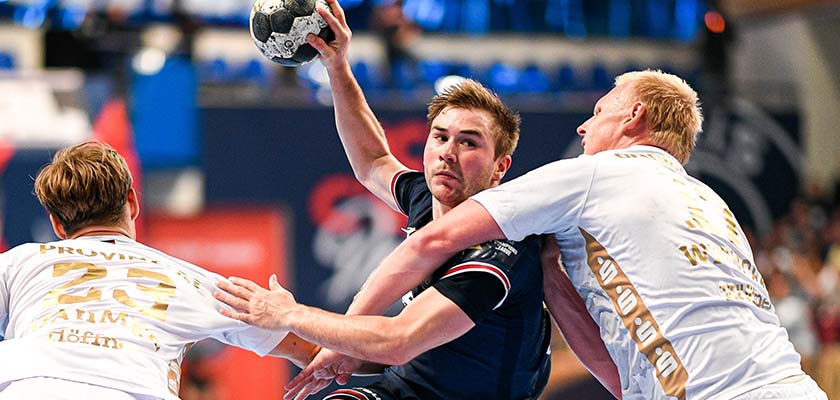Handball is a dynamic and exciting game. With a history dating back to the beginning of the 20th century, the sport has evolved and consolidated itself as a popular sport, present in national and international competitions.
If you don’t quite understand what happens in the matches, rest assured: we’ve produced this complete and up-to-date guide to the main rules of handball to help you not get lost.
Below, we’ll give you a comprehensive overview of the rules that regulate the game, such as ball control, fouls, types of offences, court dimensions, duration and much more.
Check it out 👇
What is the aim of handball?
A handball match is played between two teams, each made up of seven players. The aim of the sport is to score goals by throwing the ball with your hands in order to hit the opponent’s goal.
During the game, the players move quickly around the court, using strategies to overcome the opposition’s defence. The pass, in this sense, is a crucial tool for the team’s progress towards the goal.
While attacking, the players face opposition from defenders, who try to intercept the ball and prevent their progress. The point is scored when the ball crosses the opposing team’s goal line.
The teams therefore alternate in this dynamic of attack and defence throughout regulation time. At the end of it, the match is won by whoever has scored the most goals. In the event of a draw, extra time can be played.
Handball match duration

A professional handball match lasts 60 minutes, divided into two halves of 30 minutes each. The break between the two periods is 10 minutes.
In the event of a draw, an extra time of 10 minutes is usually played, divided into two periods of 5 minutes each.
Each team can request a 60-second technical time-out in each half. This arrangement, however, does not extend to extra time.
Handball court
The handball court is rectangular in shape, 40 metres long by 20 metres wide. Right in the centre is a line that divides the total area into two identical sides, one for each team.
Each goal has a semicircular area in front of it, called the goalkeeper’s area. The goalkeeper can only make saves within this perimeter.
The court also has the famous 7-metre line, used for penalties, which is located 7 metres from the goal.
Above the 7-metre line is the 9-metre dotted line, which is used for fouls that are lighter than penalties.
Rules of handball

- Teams | Each team consists of seven players, including a goalkeeper;
- Substitutions | The number of substitutions is unlimited, but players must enter and leave the designated area;
- Duration | A professional handball match lasts 60 minutes, divided into two halves of 30 minutes each;
- Extra time | In the event of a draw, an extra time of 10 minutes is played, divided into two halves of 5 minutes each;
- Carrying the ball | A player can only have possession of the ball for 3 seconds. After that, they must touch it to someone. With the ball in their hands without bouncing, the maximum number of steps allowed is 3;
- Infractions | Fouls are penalised by retaking the ball on the 9-metre line (less serious) or by shooting from the 7-metre line (more serious). The 7-metre shot is like the penalty kick in handball;
- Goalkeeper | The goalkeeper can walk with the ball in his hands inside his area. However, he can leave the semicircle without the ball to take part in the build-up play. Once he steps outside his perimeter, the rules for line players come into effect;
- Encroachment | No linesman may step into the goalkeeper’s area, unless he jumps before the court marker and finishes before falling to the ground. Any situation outside of this is an encroachment. As a result, possession goes to the opposing team;
- Passive play | In handball, a team cannot go too long without trying to throw balls at the opponent’s goal. If this happens, the referee signals a foul and a free kick is taken in favour of the opponent right where possession was stopped;
- It is permitted | use the open hand to try to disarm an opponent, to use the body with the arms bent to control the opponent’s attacks and to use the torso to dispute space on the court;
- It is not permitted | Pulling the ball out of an opponent’s hands, using any part of the body to try to dislodge or knock down an opponent, grabbing an opponent (including their shirt) and jumping on an opponent are not allowed.
Punishments in handball

Disciplinary punishments in handball can be of five types: verbal warnings, free kicks, 7-metre throw-ins, two-minute exclusions and expulsion from the match. It all depends on the location and degree of intensity of the foul.
The free kick occurs when a defender invades the goalkeeper’s area with the aim of gaining a spatial advantage, when the team commits deliberate delays in actions of the game, such as goal kicks and throw-ins, and when the team is penalised for passive play.
The free kick can be taken as a direct finish or a pass to a team-mate, at the player’s discretion. Free kicks are always taken from the exact spot on the court where the offence was committed.
The 7-metre shot, on the other hand, is taken at the 7-metre mark, very close to the goalkeeper. This is what we call a penalty kick in handball, which is awarded when an opponent, in a foul manner, prevents a clear chance of scoring.
The verbal warning is a mechanism adopted by the referee to warn players that if they continue to commit fouls, a more severe punishment could be handed out in the future.
Two-minute exclusions are awarded for highly serious fouls, such as blows to sensitive areas of the body, tackles with excessive force, fouls on players who are hurtling at high speed, etc.
Expulsion from the game is the most severe punishment in handball and is applied for extremely unsportsmanlike behaviour, such as aggression and disrespect towards the referee.
Now you know the rules of handball and you’re ready to watch handball matches, whether at the World Cup or the Olympics 👊
Remember that you can visit our website daily whenever you want to read complete and fresh content about sports, games and betting!



